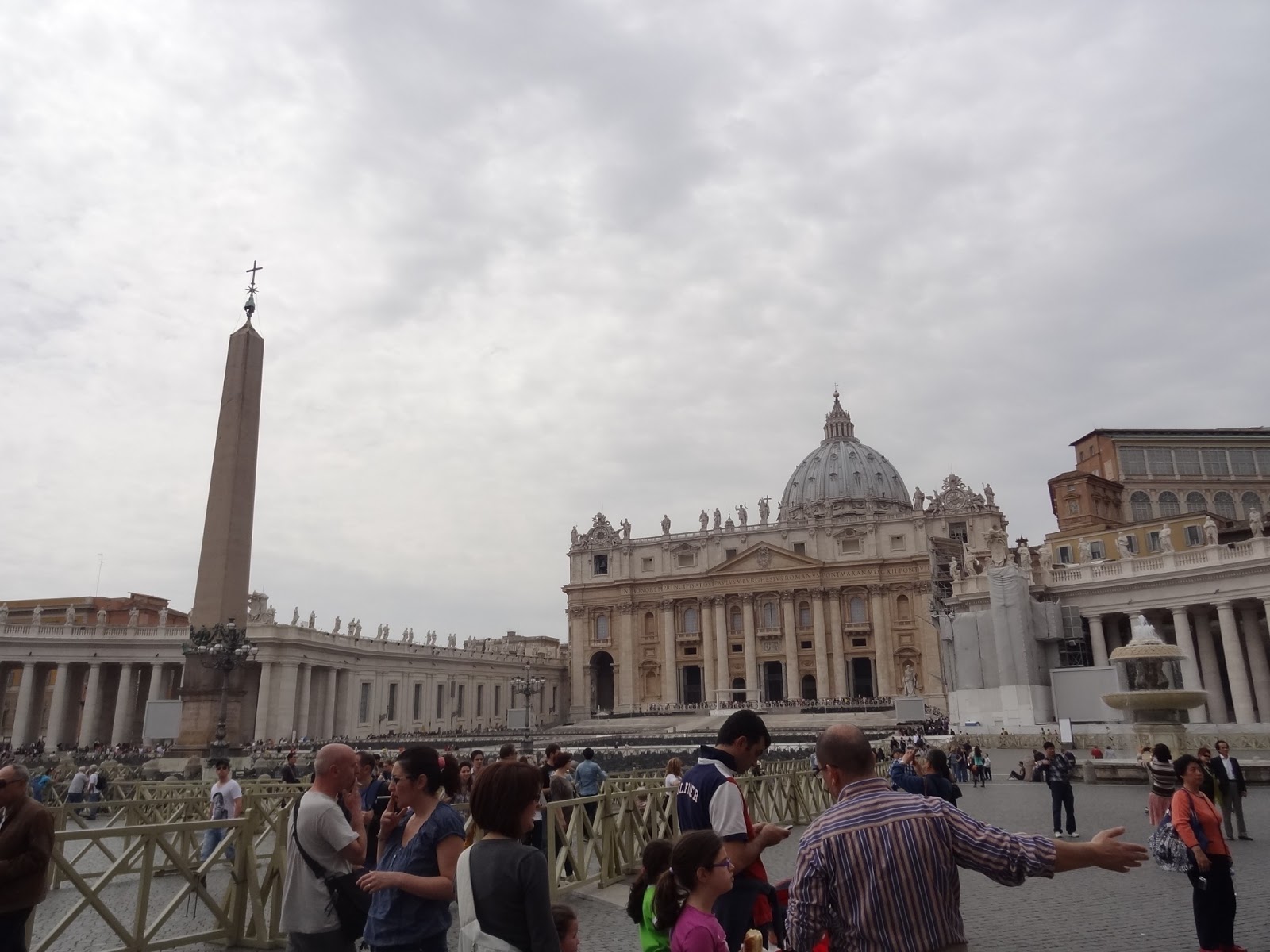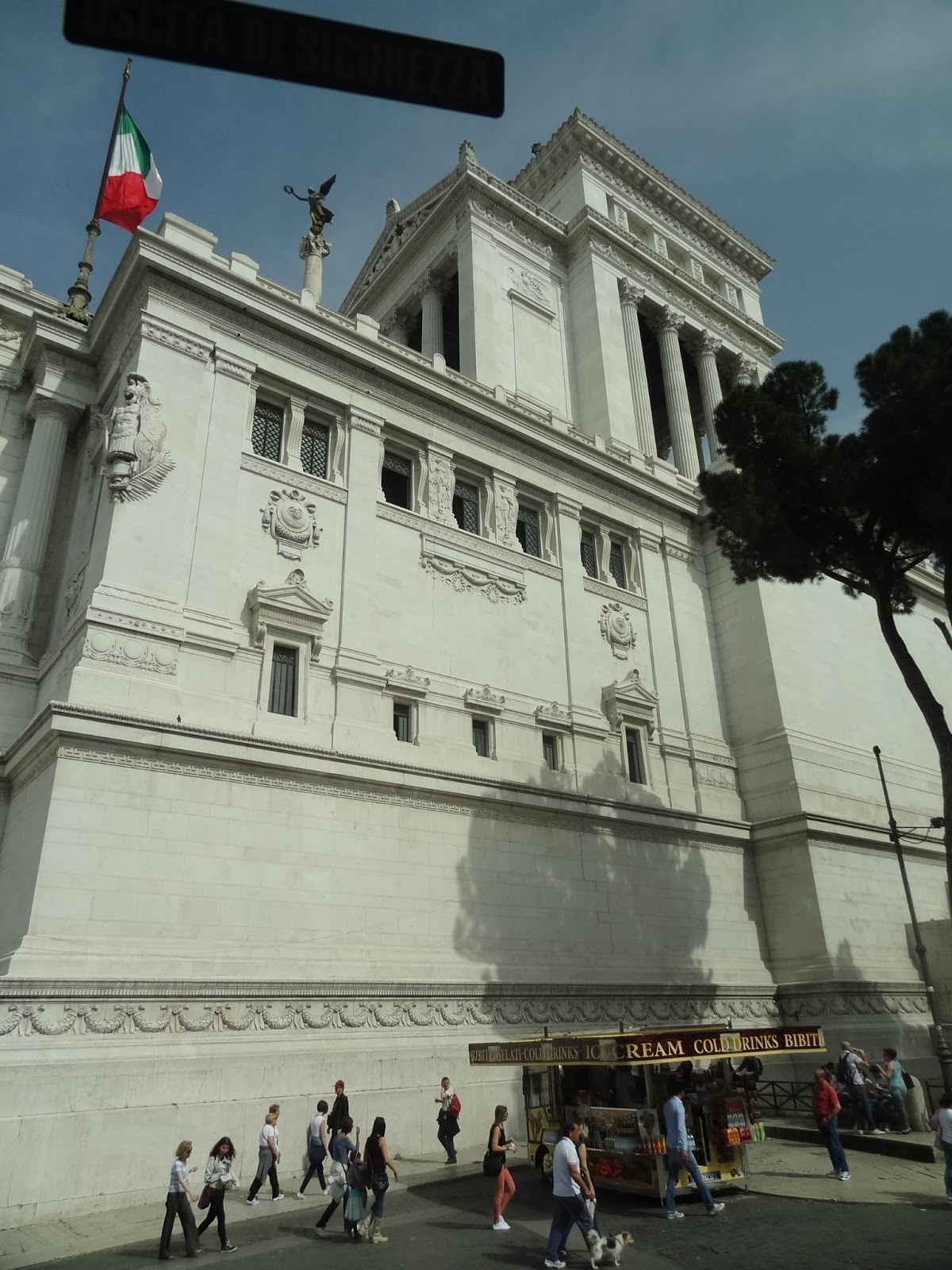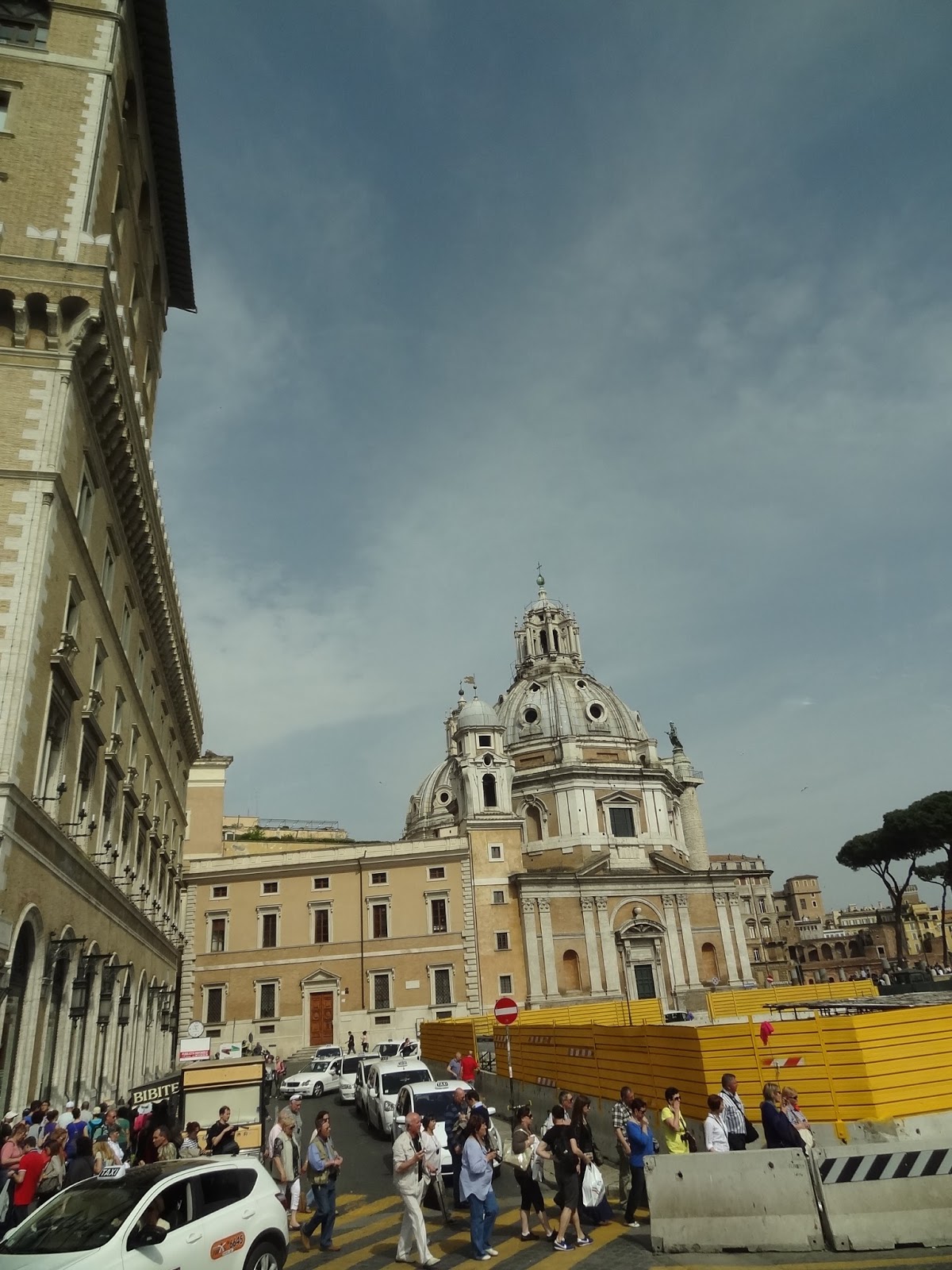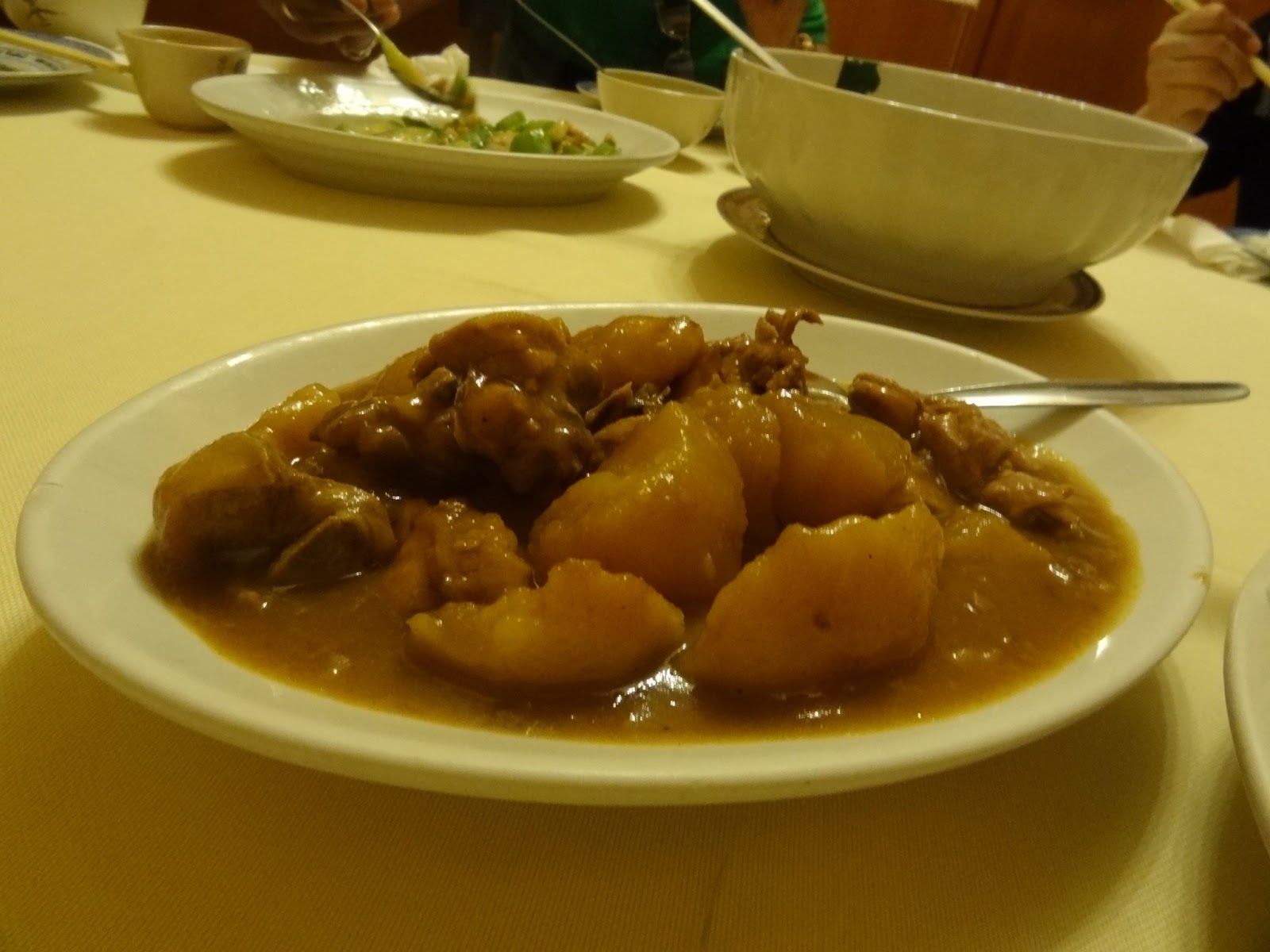This morning, it is time to depart for Vatican City and visit the St Peter's Basilica in St Peter's Square, the most famous church in the christian world.
Before reaching the St Peter's Basilica , let's have our lunch first ^^
This noon we are gonna have pasta. Nice for us but not suitable for those aunties and uncles.
They are still used to eat chinese food.
Walking under tunnel to St Peter's Basilica.
Today we have a local guide who guide us along .
Cant wait to see the world richest church .
Was told that the world donations are all consolidate here.
Correct me if wrong. LOL
Overall details of St Peter's Basilica
Below is the link :
http://saintpetersbasilica.org/
http://www.vatican.va/phome_en.htm
Before you head in maybe you need a Map of the Vatican City
Below are the link:
http://saintpetersbasilica.org/vaticancity-map.htm
History of St Peter's Basilica
Below are the link :
http://saintpetersbasilica.org/Docs/JLM/SaintPeters-1.htm

St. Peter's Basilica (Latin: Basilica Sancti Petri; Italian: Basilica di San Pietro in Vaticano) is a Late Renaissancechurch located within Vatican City.
Designed principally by Donato Bramante, Michelangelo, Carlo Maderno and Gian Lorenzo Bernini, St. Peter's is the most renowned work of Renaissance architecture[1] and remains one of the largest churches in the world.[2] While it is neither the mother church of the Roman Catholic Church nor the cathedral of the Bishop of Rome, St. Peter's is regarded as one of the holiest Catholic sites. It has been described as "holding a unique position in the Christian world"[3] and as "the greatest of all churches of Christendom".[1]
By Roman Catholic tradition, the basilica is the burial site of its namesake Saint Peter, one of the twelve apostles of Jesus and, also according to tradition, the first Bishop of Rome and therefore first in the line of the papal succession. Tradition and some historical evidence hold that Saint Peter's tomb is directly below the altar of the basilica. For this reason, many Popes have been interred at St. Peter's since the Early Christian period. There has been a church on this site since the time of Constantine. Construction of the present basilica, replacing the Old St. Peter's Basilica of the 4th century, began on 18 April 1506 and was completed on 18 November 1626.[4]
St. Peter's is famous as a place of pilgrimage, for its liturgical functions. Because of its location in the Vatican, the Pope presides at a number of services throughout the year, drawing audiences of 15,000 to over 80,000 people, either within the Vatican Basilica, or in St. Peter's Square.[5] St. Peter's has many strong historical associations, with the Early Christian church, the papacy, the Counter-reformation and with numerous artists, most significantlyMichelangelo. As a work of architecture, it is regarded as the greatest building of its age.[6] St. Peter's is one of the four churches of Rome that hold the rank of Major Basilica. Contrary to popular misconception, it is not a cathedral as it is not the seat of a bishop; the cathedra of the Bishop of Rome is located in the Archbasilica of St. John Lateran.
Was told that we will be blessed if touches the Pope Feet.


Bernini's first work at St. Peter's was to design the baldacchino, a pavilion-like structure 30 metres (98 ft) tall and claimed to be the largest piece of bronze in the world, which stands beneath the dome and above the altar. Its design is based on the ciborium, of which there are many in the churches of Rome, serving to create a sort of holy space above and around the table on which the Sacrament is laid for the Eucharist and emphasizing the significance of this ritual. Theseciboria are generally of white marble, with inlaid coloured stone. Bernini's concept was for something very different. He took his inspiration in part from the baldachin or canopy carried above the head of the pope in processions, and in part from eight ancient columns that had formed part of a screen in the old basilica. Their twisted barley-sugar shape had a special significance as they were modelled on those of the Temple of Jerusalem and donated by the Emperor Constantine. Based on these columns, Bernini created four huge columns of bronze, twisted and decorated with olive leaves and bees, which were the emblem of Pope Urban.

The altar with Bernini's baldacchino
The baldacchino is surmounted not with an architectural pediment, like most baldacchini, but with curved Baroque brackets supporting a draped canopy, like the brocade canopies carried in processions above precious iconic images. In this case, the draped canopy is of bronze, and all the details, including the olive leaves, bees, and the portrait heads of Urban's niece in childbirth and her newborn son, are picked out in gold leaf. The baldacchino stands as a vast free-standing sculptural object, central to and framed by the largest space within the building. It is so large that the visual effect is to create a link between the enormous dome which appears to float above it, and the congregation at floor level of the basilica. It is penetrated visually from every direction, and is visually linked to the Cathedra Petri in the apse behind it and to the four piers containing large statues that are at each diagonal.[15][31]
As part of the scheme for the central space of the church, Bernini had the huge piers, begun by Bramante and completed by Michelangelo, hollowed out into niches, and had staircases made inside them, leading to four balconies. There was much dismay from those who thought that the dome might fall, but it did not. On the balconies Bernini created showcases, framed by the eight ancient twisted columns, to display the four most precious relics of the basilica: the spear of Longinus, said to have pierced the side of Christ, the veil of Veronica, with the miraculous image of the face of Christ, a fragment of the True Cross discovered in Jerusalem by Constantine's mother, Helena, and a relic of St. Andrew, the brother of St. Peter. In each of the niches that surround the central space of the basilica was placed a huge statue of the saint associated with the relic above. Only St. Longinus is the work of Bernini.[15]
The apse with St. Peter's Cathedra supported by four Doctors of the Church
Bernini then turned his attention to another precious relic, the so-called Cathedra Petri or "throne of St. Peter" a chair which was often claimed to have been used by the apostle, but appears to date from the 12th century. As the chair itself was fast deteriorating and was no longer serviceable, Pope Alexander VII determined to enshrine it in suitable splendour as the object upon which the line of successors to Peter was based. Bernini created a large bronze throne in which it was housed, raised high on four looping supports held effortlessly by massive bronze statues of four Doctors of the Church, Saints Ambrose and Augustine representing the Latin Church and Athanasius and John Chrysostom, the Greek Church. The four figures are dynamic with sweeping robes and expressions of adoration and ecstasy. Behind and above the Cathedra, a blaze of light comes in through a window of yellow alabaster, illuminating, at its centre, the Dove of the Holy Spirit. The elderly painter, Andrea Sacchi, had urged Bernini to make the figures large, so that they would be seen well from the central portal of the nave. The chair was enshrined in its new home with great celebration of 16 January 1666.[15][31]
Bernini's final work for St. Peter's, undertaken in 1676, was the decoration of the Chapel of the Sacrament.[41] To hold the sacramental Host, he designed a miniature version in gilt bronze of Bramante's Tempietto, the little chapel that marks the place of the death of St. Peter. On either side is an angel, one gazing in rapt adoration and the other looking towards the viewer in welcome. Bernini died in 1680 in his 82nd year.[15]
Time to change the guards
Cute little gal sleeping on dad's shoulder.
There is a mosquito bite on her cheek makes her even more cute.
After visiting Vatican City, now we are heading to view the Colosseum, originally known as Flavian Amphitheatre, where ancient gladiators fought for the public's entertainment.
Rome - The Colosseum
Website :
http://www.aviewoncities.com/rome/colosseo.htm
The Flavian Amphitheater
Emperor Vespasian, founder of the Flavian Dynasty, started construction of the Colosseum in 72 AD. It was completed in 80 AD, the year after Vespasian's death.
The huge amphitheater was built on the site of an artificial lake, part of Nero's huge park in the center of Rome which also included the Golden House (Domus Aurea) and the nearby Colossus statue. This giant statue of Nero gave the building its current name.
The Arch of Constantine (Italian: Arco di Costantino) is a triumphal arch in Rome, situated between the Colosseum and thePalatine Hill. It was erected by the Roman Senate to commemorate Constantine I's victory over Maxentius at the Battle of Milvian Bridge on October 28, 312.[1] Dedicated in 315, it is the latest of the existing triumphal arches in Rome, and the only one to make extensive use of spolia, re-using several major reliefs from 2nd century imperial monuments, which give a striking and famous stylistic contrast to the sculpture newly-created for the arch.
The arch spans the Via Triumphalis, the way taken by the emperors when they entered the city in triumph. This route started at the Campus Martius, led through the Circus Maximus and around the Palatine Hill; immediately after the Arch of Constantine, the procession would turn left at the Meta Sudans and march along the Via Sacra to the Forum Romanum and on to the Capitoline Hill, passing both the Arches of Titus and Septimius Severus.
The Colosseum was built of blocks of travertine stone extracted from the quarries of Albulae near Tivoli and brought to Rome by a wide road specially constructed for the purpose. The amphitheater forms an oval 527 meters ( 1,729) in circumference with diameters of 189 and 156 meters (615 and 510 ft). The height of the four-storied wall is 48 meters (157 ft).
The Colosseum contained 45,000 sitting places and 5,000 standing places. The broad paved circular piazza that surrounded the amphitheater allowed easy access to every part of the façade. There were 80 entrance arches, of these the four at the extremities of the major and minor axes were forbidden to the public and not numbered. The major axis entrances gave direct unrestricted access to the arena itself. In contrast both of the minor axis entrances gave direct access to special reserved boxes.
Soon after the Colosseum, we will move on to visit the Trevi Fountain and Spanish Steps.
After that we will have free and easy time to shop to shop along Via Condotti , one of the Romse's most elegant shopping streets.
Beware of pickpockets here.
They are usually hiding in the crowd and personally I seen one when I am there.
Usually for those who are free and easy, you may want to take out your coin and put in your pocket. Rather you choose to take out your whole wallet near the wishing fountain.
Seriously the place is very nice but this place give me the most fear after travelling around to so many places. Really gonna be careful.
- Trevi Fountain -
You will not find any other place in the world that celebrates the ever-mutating and incredible power of water like Rome. The Trevi Fountain is a fantastic work of art that is much more than a mere sculpture. This triumphant example of Baroque art with its soft, natural lines and fantasy creatures embodies movement as the soul of the world. The fountain is a true wonder, a jewel of water and stone that is nestled between the palaces of the historic centre of the city.
You can already hear its presence from the nearby streets. Indeed, as you get nearer the sound of its gushing waters grows constantly more intense,reaching a crescendo in the square, where you will find the most breathtaking sight. Suddenly, the space seems to open out and you stand before a symbolic representation of this great force of nature, a tumultuous spring that seems to flow out of the ground.
The light and shade effects on the marble make the wind seem to bellow through the drapes and locks of the statues, agitating the waves, creating an extraordinarily intense and spectacular scene. In this Baroque creation, the architecture itself seems to come alive with the current of the revitalising waters.
Even the palace in the background blends perfectly with the compositionand the game of space and mass gives an air of movement to the entire statue. The central feature of the monument is a chariot in the shape of a shell, drawn by seahorses with Triton as their guide. Before the enormous central niche stands Oceanus. To the side are the statues of Abundance andSalubrity. All around, natural and artificial forms merge together in a representation of rocks and petrified vegetation that run along the foundation of the palace and around the borders of the pool, which represents the sea.
This unique statue has an ancient history. Its origins go back to Roman timesand it was the terminal point of the Aqua Virgo aqueduct commissioned byAugustus, which was used to provide water for the thermal baths. The water that flows here has two names: Virgin Waters and Trevi. The first refers to an ancient legend about a young Roman girl who showed the source of the spring to some thirsty soldiers; whereas Trevi derives from the old name for the area, which was originally called Trebium.
The aqueduct continued to function, even though it was necessary to wait until the eighteenth century when Pope Clement XII decided to restore the Trevi district and began work on the fountain we know today. It took three centuries to complete and is often attributed to Bernini, but for the most part it is the work of the Roman architect, Nicola Salvi, who took twenty years to complete it.
This work of art is so famous that even cinema has commemorated it on more than one occasion. Everyone remembers the scene in the renowned Italian film, "La Dolce Vita" by Fellini; on a quiet night in an almost unreal Rome, an alluring Anita Ekberg jumps into the Trevi Fountain with her clothes on and invites Marcello Mastroianni to join her.
- Coin throwing -
There is also another curious tradition regarding the Trevi Fountain. It is said that if you throw a coin over your shoulder into the water, you will be sure to return to Rome. An estimated 3,000 euros in coins are thrown into the fountain every day.
Yup here we are at the Spanish Steps
Extracted from : http://www.italyguides.it/us/roma/spanish_steps.htm
- The Spanish Steps ( Piazza di Spagna ) -
With its characteristic butterfly plan, the Piazza di Spagna is one of the most famous images in the world, as well as being one of the most majestic urban monuments of Roman Baroque style. In the Renaissance period, the square was the most popular tourist attraction in the city: it attracted artists and writers alike and was full of elegant hotels, inns and residences.
At the end of the seventeenth century, it was called Trinità dei Monti, after the church that dominates the square from above, but it was later given the name we know today after the Spanish Ambassador who lived there.
At the foot of the stairs, you will find the famous Barcaccia Fountain, the work of Pietro Bernini and his son, Gian Lorenzo. The latter went on to become the creator of some of the most important masterpieces of Baroque art in the city, including the renowned baldachino of St. Peter's Basilica. With its characteristic form of a sinking ship, the fountain recalls the historic flood of the River Tiber in 1598 and refers to a folk legend whereby a fishing boat carried away by the flood of the river was found at this exact spot. In reality, the sinking boat was ably invented by Bernini to overcome a technical problem due to low water pressure. The sun and bee ornamentation is a symbol of the Barberini family and a reference to Pope Urban VIII who commissioned the work. However, the main attraction of the square has to be the spectacular staircase of Trinità dei Monti.
Built on the request of Innocent XII and created by Francesco De Sanctis in the eighteenth century, this daring architectural feat with its ramps and stairs that intersect and open out like a fan definitively provided a solution for connecting the square and the Trinità Church above, providing the city with a particularly intriguing attraction that is adored by tourists from all over the world. The sight of the square in spring should not be missed, when the ramps of the staircase are literally covered with flowers and the architecture is playfully lost beneath a magnificent array of colour.
Yummy Chinese Dinner
Mr Goh came here back in the 90 s'
A place worth visiting for dinner
Orange Trees?
Serious ?
Along the street ?
YES !
Yup checking in to Hotel in Rome
BW ROMA TOR VERGATA
Via Vico Vigano 24, Angolo
Viali Duilio Cambellotti, Rome
Day 15: 26th April 2013 Friday
Flying back to Singapore. Doing last min shopping at the airport
Bought a Furla bag at the airport.
Limited design with tax free.
To conclude my 16 days of Honey Moon At Europe.
It was fun, exciting and there are so many first time for me. First time traveled so far with my dear hubby. Especially first time see snow together.
I believe when I am old, I will never forget this memorable trip that I had with you.
I hope down the road in our life journey, I can travel the world with you
and keep blogging about us. =)
Thanks you people who are following my posts.
Will update my blog as frequent as possible .



































































































































































































